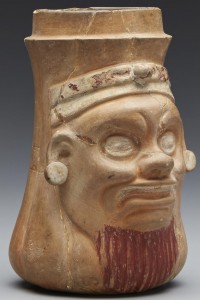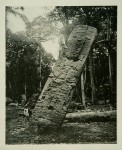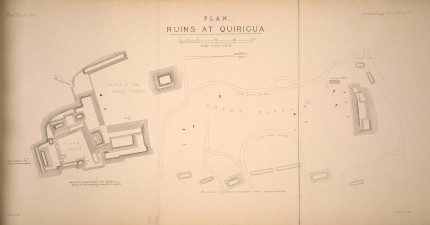 One of the artifacts that was controversially put up for auction by the St. Louis Society of the American Institute for Archaeology last year has been acquired by the Dallas Museum of Art. It’s the effigy vase from the Late Classic Era (700-900 A.D.) excavated at Quiriguá, Guatemala, in 1911. According to a December press release from the St. Louis Society, the vase was bought by a university museum, but the DMA is not affiliated with a university so either it passed through another set of hands over the last three months or the release was mistaken.
One of the artifacts that was controversially put up for auction by the St. Louis Society of the American Institute for Archaeology last year has been acquired by the Dallas Museum of Art. It’s the effigy vase from the Late Classic Era (700-900 A.D.) excavated at Quiriguá, Guatemala, in 1911. According to a December press release from the St. Louis Society, the vase was bought by a university museum, but the DMA is not affiliated with a university so either it passed through another set of hands over the last three months or the release was mistaken.
“We are delighted that the Maya effigy vase, a beautiful work of ancient American art, has found a new home in our institution,” said Maxwell L. Anderson, The Eugene McDermott Director of the DMA. “Given the art historical importance of this pre-Columbian vessel, its clearly documented provenance, and its cultural heritage in the Americas, the DMA deemed it important to maintain this historical vase within a public collection, one which offers free access to visitors interested in seeing it and to scholars for research and publication.”
“The vase is a stunning example of Late Classic Maya modeled ceramic art. Its acquisition both advances the DMA’s ancient Americas collection and offers a striking object for appreciating the diversity and refinement of Maya visual representation,” added Kimberly L. Jones, the Museum’s Ellen and Harry S. Parker III Assistant Curator of Arts of the Americas.
 Quiriguá was first explored by Europeans in 1840 when artist Frederick Catherwood, partner of travel writer John Lloyd Stephens, sought out the rumored ruins on the banks of the Motagua River in southeastern Guatemala in 1840. They found monoliths, altars and a number of obelisk-like stelae elaborately carved on all four sides that remain to this day the tallest ever discovered in the Mayan world. Stela E, dedicated in 771 A.D. by the city-state’s greatest hero, King K’ak’ Tiliw Chan Yopaat (meaning Cauac, or Rain/Storm, Sky), is almost 35 feet high and weighs 65 tons. It is the largest stone ever quarried by the Maya and is believed to be the largest free-standing carved monolith in the Americas.
Quiriguá was first explored by Europeans in 1840 when artist Frederick Catherwood, partner of travel writer John Lloyd Stephens, sought out the rumored ruins on the banks of the Motagua River in southeastern Guatemala in 1840. They found monoliths, altars and a number of obelisk-like stelae elaborately carved on all four sides that remain to this day the tallest ever discovered in the Mayan world. Stela E, dedicated in 771 A.D. by the city-state’s greatest hero, King K’ak’ Tiliw Chan Yopaat (meaning Cauac, or Rain/Storm, Sky), is almost 35 feet high and weighs 65 tons. It is the largest stone ever quarried by the Maya and is believed to be the largest free-standing carved monolith in the Americas.
 The carving on Stela E celebrated K’ak’ Tiliw Chan Yopaat greatest victory, the defeat, capture and beheading of King Uaxaclajuun Ub’aah K’awiil (18 Rabbit) of Copán. For centuries before then Quiriguá had been a vassal state of Copán, so when Cauac Sky defeated 18 Rabbit in 738 A.D., he won his kingdom’s independence. The victory had larger political implications for the power balance of the region. Copán was allied to the Mayan superpower state of Tikal. Historians believe that Cauac Sky’s rebellion was fomented by Calakmul, Tikal’s rival superpower to the north. After Copán’s defeat, Quiriguá controlled the trade of precious stones and other goods on the lower Montagua River, the main trade route linking the Caribbean and Mayan central America.
The carving on Stela E celebrated K’ak’ Tiliw Chan Yopaat greatest victory, the defeat, capture and beheading of King Uaxaclajuun Ub’aah K’awiil (18 Rabbit) of Copán. For centuries before then Quiriguá had been a vassal state of Copán, so when Cauac Sky defeated 18 Rabbit in 738 A.D., he won his kingdom’s independence. The victory had larger political implications for the power balance of the region. Copán was allied to the Mayan superpower state of Tikal. Historians believe that Cauac Sky’s rebellion was fomented by Calakmul, Tikal’s rival superpower to the north. After Copán’s defeat, Quiriguá controlled the trade of precious stones and other goods on the lower Montagua River, the main trade route linking the Caribbean and Mayan central America.
K’ak’ Tiliw Chan Yopaat ruled from 724 to 785 A.D. In the 37 years between Quiriguá’s independence and the death of the king, he commissioned many of the stelae, zoomorphs, altars, etc. that make the site such a spectacular example of Mayan stonework. He probably got the stonecutters from Copán, in fact, since there is an absence of carved inscriptions in Copán for 20 years after the city’s defeat.
Catherwood’s drawings of the stelae with their hieroglyphs, zoomorphs, kings and Mayan calendar dates coupled with Stephens’ account of their travels introduced the wider public to Mayan art and architecture when they were published the next year in Incidents of Travel in Central America, Chiapas, and Yucatan. British Diplomat and archaeologist Alfred Percival Maudslay explored Quiriguá on repeated trips in 1881, 1882, 1883 and 1894. He and his team cleared some of the jungle brush to reveal more works and used techniques like making plaster casts of the stone monuments and taking pictures with dry-plate photography (only introduced to the market in 1878). There’s a selection of pictures from Maudslay’s excavations in the Alfred P. Maudslay collection of the Brooklyn Museum. You can also leaf through his pictures, maps and drawings of Quiriguá in volume 2 of Maudslay’s five-volume compendium Biologia Centrali-Americana, or, Contributions to the knowledge of the fauna and flora of Mexico and Central America published in 1889.

In 1909, the St. Louis Society of the Archaeological Institute of America funded three seasons of fieldwork at Quiriguá by Edgar Hewett, director of the newly-founded School of American Archaeology (SAA) in Santa Fe, New Mexico, and SAA archaeologist Sylvanus Morley. Hewett and Morley’s excavations cleared even more of the jungle and unearthed two major structures Hewett termed the First and Second Temples. Temple 1 is far more significant architecturally, with complex carvings on the inside and outside walls. Temple 2 is small and sparsley decorated, but it’s the earliest of the structures in the Quiriguá Acropolis and was found to contain artifacts distinctly superior to those found in Temple 1 both in quantity and quality.
 According to Morley’s publication of the finds in the March 1913 issue of National Geographic, the most exceptional find from all three seasons of excavations was the effigy vase found in Temple 2 during the 1911-2 season. Discovered broken in more than a dozen pieces, once the object was put back together its quality made it the stand-out piece and for decades it regularly made an appearance in published studies of Mayan art. Hewett and Morley gave the effigy along with a Zapotec figural urn excavated at Monte Albán, Mexico, to the St. Louis Society in gratitude for their funding.
According to Morley’s publication of the finds in the March 1913 issue of National Geographic, the most exceptional find from all three seasons of excavations was the effigy vase found in Temple 2 during the 1911-2 season. Discovered broken in more than a dozen pieces, once the object was put back together its quality made it the stand-out piece and for decades it regularly made an appearance in published studies of Mayan art. Hewett and Morley gave the effigy along with a Zapotec figural urn excavated at Monte Albán, Mexico, to the St. Louis Society in gratitude for their funding.
The Maya effigy vase was on display at the Saint Louis Art Museum until 1980 when it was removed to make way for a donation of Mesoamerican artifacts by Morton D. May. The effigy was then put in storage at Washington University until the St. Louis Society decided to sell it at a Bonhams auction in November of last year.
An few interesting things about Quirgua: the river used to run next to the site, it now is about a mile away, the main temple was faced with a local white calcite. Not much of the white stone remains but its effect must have been striking. The site is maybe a tenth excavated, one gets a nice prospective of how the site looked when it was still covered with earth and vegetation.